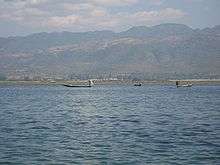Intha people
| အင်းသား | |
|---|---|
 Traditional leg rowing of the Intha | |
| Regions with significant populations | |
| 70,000 | |
| Languages | |
| Intha dialect of the Burmese language | |
| Religion | |
| Theravada Buddhism | |
| Related ethnic groups | |
| Bamar, Arakanese | |
The Intha (Burmese: အင်းသားလူမျိုး; MLCTS: ang: sa: lu. myui:, IPA: [ɪ́ɴðá lùmjóʊ]; lit. "sons of the lake") are members of a Tibeto-Burman ethnic group living around Inle Lake. They speak an archaic dialect of Burmese and are believed to have come from the Dawei area. They often live on Inle Lake and support themselves through the tending of vegetable farms on floating gardens. Also, the Intha are known for their leg-rowing techniques and are traditionally Buddhists.
The people of Inle Lake (called Intha), some 70,000 of them, live in four cities bordering the lake, in numerous small villages along the lake's shores, and on the lake itself. The entire lake area is in Nyaung Shwe township. The population consists predominantly of Intha, with a mix of other Shan, Taungyo, Pa-O (Taungthu), Danu, Kayah, Danaw and Bamar ethnicities. Most are devout Buddhists and live in simple houses of wood and woven bamboo on stilts; they are largely self-sufficient farmers.
Most transportation on the lake is traditionally by small boats, or by somewhat larger boats fitted with 'long-tail' motors that are necessary because of the usual shallowness of the lake. Local fishermen are known for practicing a distinctive rowing style which involves standing at the stern on one leg and wrapping the other leg around the oar. This unique style evolved for the reason that the lake is covered by reeds and floating plants making it difficult to see above them while sitting. Standing provides the rower with a view beyond the reeds. However, the leg rowing style is only practiced by the men. Women row in the customary style, using the oar with their hands, sitting cross legged at the stern.
